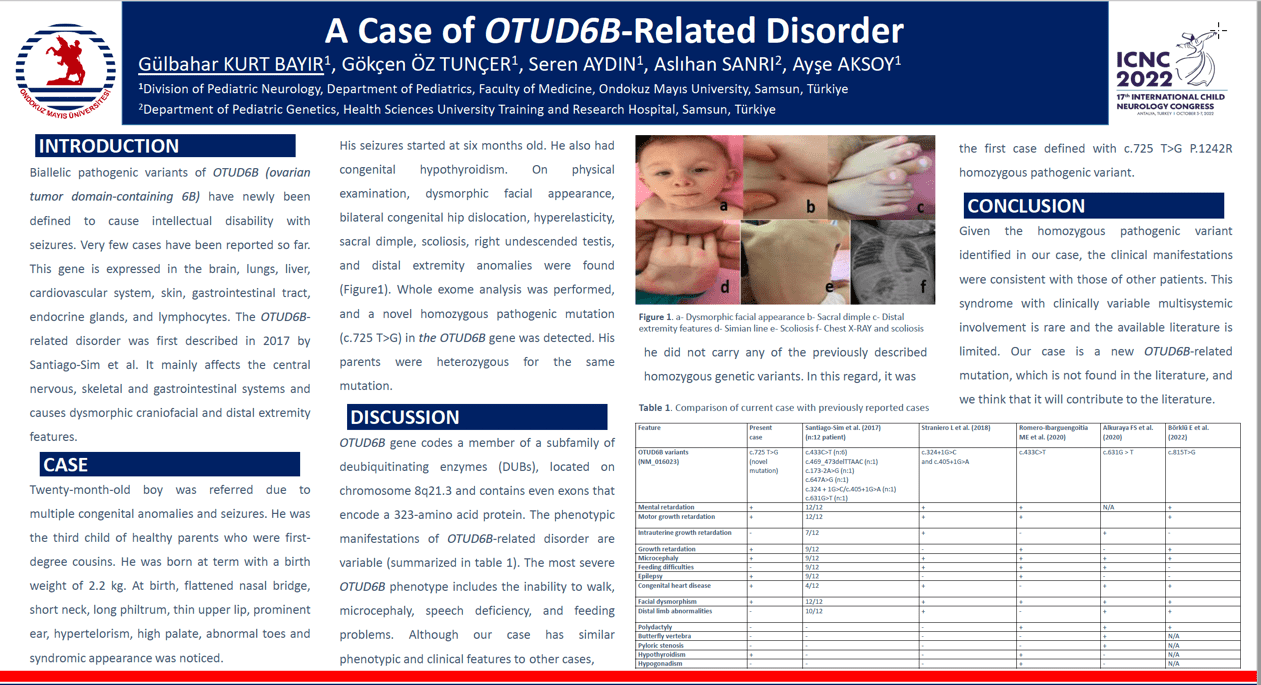A Case of OTUD6B-Related Disorder
Gülbahar KURT BAYIR, Gökçen ÖZ TUNÇER, Seren AYDIN, Aslıhan Sanrı, Ayşe AKSOY
Introduction: Biallelic pathogenic variants of OTUD6B (ovarian tumor domain-containing 6B) have newly been defined to cause intellectual disability (ID) with seizures. This gene is expressed in the brain, lungs, liver, cardiovascular system, skin, gastrointestinal tract, testicles, adrenal glands, adipose tissue, pancreas, thyroid, and lymphocytes. This multisystem disorder mostly affects the central nervous system, skeletal systems, and gastrointestinal systems, as well as dysmorphic craniofacial and distal extremity features. Case: Twenty-month-old boy was referred due to multiple congenital anomalies. He was third child of healthy parents who were first-degree cousins. He was born at term with a birth weight of 2.2 kg. At birth, the nasal root was flattened, short neck, long philtrum, thin upper lip, prominent ear, hypertelorism, high palate, and abnormal toes and syndromic appearance was present. His seizures started when he was six months old. On physical examination dysmorphic facial appearance, bilateral congenital hip dislocation, hyperelasticity, sacral dimple, progressive scoliosis, right undescended testis, and distal extremity anomalies were found. Whole exome analysis was performed and a homozygous pathogenic mutation novel (c.725 T>G) in OTUD6B gene was detected. In its segregation, his parents were heterozygous for the same mutation. Conclusion: Knowing the clinical impact of rare genetic variants on the organs and systems that could be affected, guides the physician to intentionally review them. That's why an action plan can be established for the patient’s medical administration and improvement in his quality of life.
Keywords: OTUD6B gene; multiple congenital anomalies; intellectual disability
Gülbahar KURT BAYIR
Ondokuz Mayıs University, Faculty of Medicine
Turkey
Gökçen ÖZ TUNÇER
Ondokuz Mayıs University, Faculty of Medicine
Turkey
Seren AYDIN
Ondokuz Mayıs University, Faculty of Medicine
Turkey
Aslıhan Sanrı
University of Health Sciences, Samsun Training and Research Hospital
Turkey
Ayşe AKSOY
Ondokuz Mayıs University, Faculty of Medicine
Turkey
Introduction: Biallelic pathogenic variants of OTUD6B (ovarian tumor domain-containing 6B) have newly been defined to cause intellectual disability (ID) with seizures. This gene is expressed in the brain, lungs, liver, cardiovascular system, skin, gastrointestinal tract, testicles, adrenal glands, adipose tissue, pancreas, thyroid, and lymphocytes. This multisystem disorder mostly affects the central nervous system, skeletal systems, and gastrointestinal systems, as well as dysmorphic craniofacial and distal extremity features. Case: Twenty-month-old boy was referred due to multiple congenital anomalies. He was third child of healthy parents who were first-degree cousins. He was born at term with a birth weight of 2.2 kg. At birth, the nasal root was flattened, short neck, long philtrum, thin upper lip, prominent ear, hypertelorism, high palate, and abnormal toes and syndromic appearance was present. His seizures started when he was six months old. On physical examination dysmorphic facial appearance, bilateral congenital hip dislocation, hyperelasticity, sacral dimple, progressive scoliosis, right undescended testis, and distal extremity anomalies were found. Whole exome analysis was performed and a homozygous pathogenic mutation novel (c.725 T>G) in OTUD6B gene was detected. In its segregation, his parents were heterozygous for the same mutation. Conclusion: Knowing the clinical impact of rare genetic variants on the organs and systems that could be affected, guides the physician to intentionally review them. That's why an action plan can be established for the patient’s medical administration and improvement in his quality of life.
Keywords: OTUD6B gene; multiple congenital anomalies; intellectual disability
Gülbahar KURT BAYIR
Ondokuz Mayıs University, Faculty of Medicine
Turkey
Gökçen ÖZ TUNÇER
Ondokuz Mayıs University, Faculty of Medicine
Turkey
Seren AYDIN
Ondokuz Mayıs University, Faculty of Medicine
Turkey
Aslıhan Sanrı
University of Health Sciences, Samsun Training and Research Hospital
Turkey
Ayşe AKSOY
Ondokuz Mayıs University, Faculty of Medicine
Turkey

Gülbahar KURT BAYIR
Ondokuz Mayıs University, Faculty of Medicine Turkey
Ondokuz Mayıs University, Faculty of Medicine Turkey